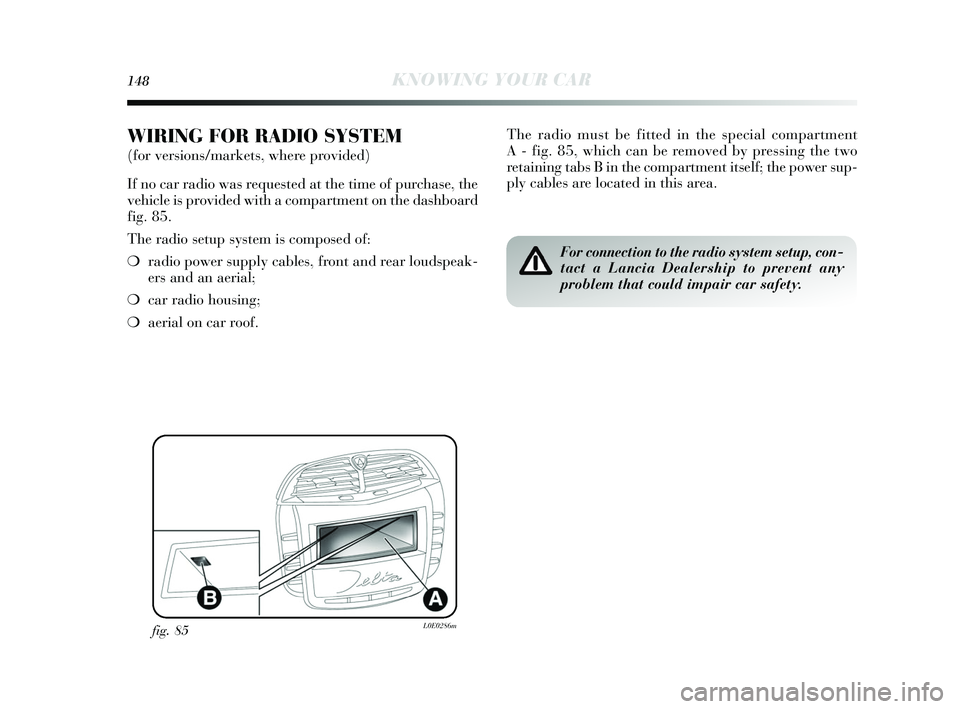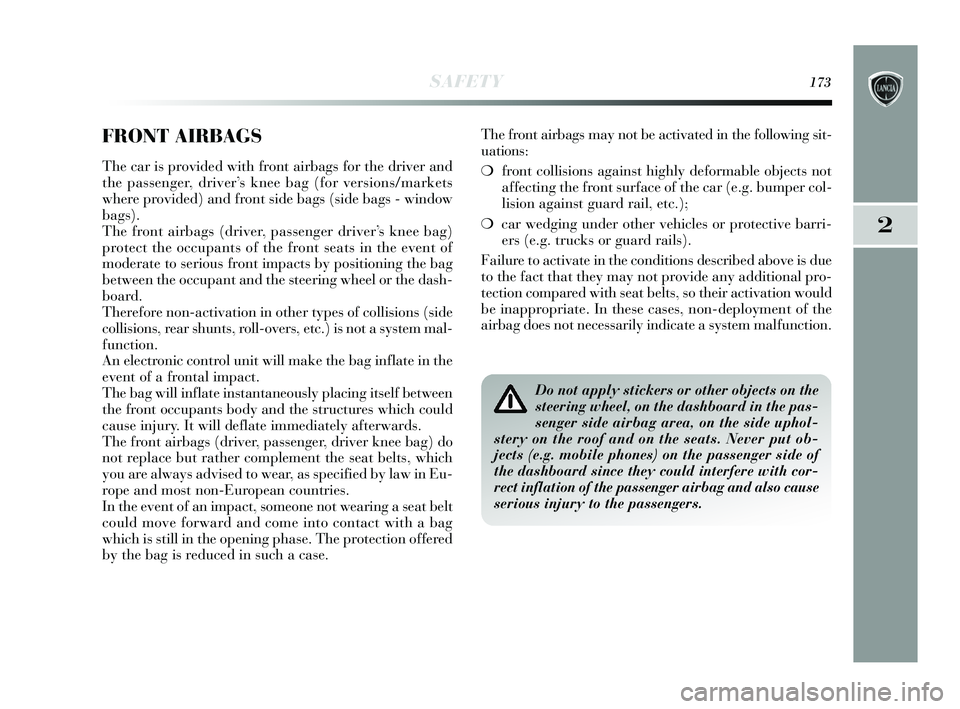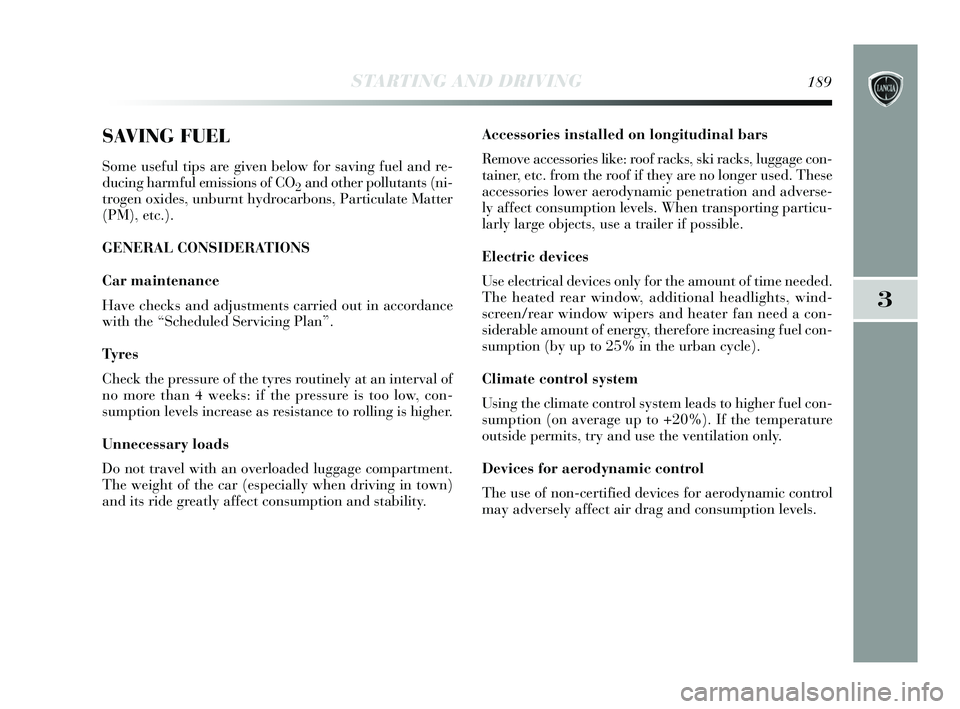roof Lancia Delta 2015 Owner handbook (in English)
[x] Cancel search | Manufacturer: LANCIA, Model Year: 2015, Model line: Delta, Model: Lancia Delta 2015Pages: 291, PDF Size: 6.74 MB
Page 89 of 291

KNOWING YOUR CAR87
1
Closing
With the roof in the fully open position, press button A -
fig. 53 and, if the button is operated for more than half a
s econd, the front roof gla ss will automatically a ssume the
intermediate pos ition (comfort po sition).
If the button is operated again for about half a second the
roof will assume the s poiler position. Lastly, if the clos ing
button i s pressed again, the roof will a ssume the fully clos ed
pos ition.
fig. 53L0E0108m
Use the sunroof only at “spoiler” position if
cross roof racks are fitted. Never open the roof
in presence of snow or ice to prevent damage.
When leaving the vehicle, always remove the
key from the ignition to avoid the risk of in-
jury to those still inside the car due to acci-
dental operation of the sunroof. Improper use of the
roof can be dangerous. Before and during operation,
always check that nobody is at risk of being injured
by the moving sun roof or by objects getting caught
or hit by it.
Anti-pinch device
The sun roof has an anti-pinch safety system capable of
detecting the pres ence of an obstacle whilst the roof is clos-
ing: if this happens, the system intervenes and the move-
ment of the glass i s immediately reversed.
IMPORTANT The blind will remain in the full
y open po si-
tion when clo sing the sun roof. If you would like to clo se it,
this mus t be done manuall y.
001-154 Delta GB 1ed 03/03/14 10.00 Pagina 87
Page 90 of 291

88KNOWING YOUR CAR
fig. 54L0E0109m
INITIALISATION PROC EDURE
After the battery has been dis connected or a fu se has blown,
the operation of the s un roof must be initialised again.
Proceed as follows:
❍ press button A - fig. 53 until the s un roof is complete-
l y clos ed. Releas e the button;
❍ press and hold down button A for at lea st 10 s econds
and/or until the glass panel moves forwards by one
click. Releas e the button at this point;
❍ press button A within 5 seconds of this operation and
keep it pressed: the glass panel will complete a full
opening and clo sing cy cle. Releas e the button only at
the end of this cycle. EMERGENC
Y MANOEUVRE
If the s witch doe s not work, the s un r
oof can be operated
manually as follows :
❍ remove protective cap A - fig. 54 on the rear part of
the internal cover;
❍ take the Allen ke y provided from the container with
the on-board documentation or from the luggage com-
partment (ver sions with Fix&G o automatic);
❍ fit the key into seat B and turn it:
– clockwis e to open the s unroof;
– anticlockwis e to close the roof.
001-154 Delta GB 1ed 03/03/14 10.00 Pagina 88
Page 95 of 291

KNOWING YOUR CAR93
1
Window opening
Push the buttons to open/close the desired window. When
one of the two buttons is pressed briefly , the window moves
in “s tages ”; if the button i s held down, “continuous au-
tomatic” operation i s activated. If the button is pressed
again the window will stop in its current pos ition. Hold-
ing the button pre ssed for a few seconds will automati-
cally raise or lower the window (onl y with key at MAR).
Window closing
Lift the buttons to close the des ired window.
The window clo sing stage occurs following the s ame log-
ic des cribed for the opening stage.
Improper use of the electric windows can be
dangerous. Before and during its operation
ensure that any passengers are not at risk
from the moving roof either by personal objects get-
ting caught in the mechanism or by being injured
by it directly.
Always remove the ignition key when you get
out of the car to prevent the sunroof from be-
ing operated accidentally and constituting a
danger to the people still on board.
fig. 59L0E0045m
Passeng er side front door/rear doors
On the passenger side front door control panel, and on
s ome vers ions also on the rear doors , buttons F - fig. 59
are provided to control the a ssociated windows.
001-154 Delta GB 1ed 03/03/14 10.00 Pagina 93
Page 106 of 291

104KNOWING YOUR CAR
ROOF RACK/SKI RACK
FASTENERS
The attachments are located in the areas illustrated in fig.
68 and can onl y be reached with the doors open.
Lineaccessori provides a specific roof rack/s ki rack for the
tailgate.
IMPORTANT Follow the in structions contained in the as -
s embly kit carefully . Assembly must be performed by qual-
ified pers onnel.
fig. 68L0E0111m
Always comply with local legislation re-
garding maximum load size.
After having travelled several kilometres
check that the attachment fixing screws are
properly fastened.
Distribute the load uniformly and when dri-
ving take into consideration the increased
sensitivity to cross winds.
Never exceed the maximum permitted loads;
see chapter “6”.
001-154 Delta GB 1ed 03/03/14 10.00 Pagina 104
Page 150 of 291

148KNOWING YOUR CAR
WIRING FOR RADIO SYSTEM
(for versions/markets , where provided)
If no car radio wa s reques ted at the time of purchas e, the
vehicle is provided with a compartment on the da shboard
fig. 85.
The radio setup system is composed of:
❍ radio power s upply cables , front and rear loud speak-
ers and an aerial;
❍ car radio hous ing;
❍ aerial on car roof.
fig. 85L0E0286m
The radio mus t be fitted in the special compartment
A - fig. 85, which can be removed by pressing the two
retaining tabs B in the compartment its elf; the power sup-
ply cables are located in thi s area.
For connection to the radio system setup, con-
tact a Lancia Dealership to prevent any
problem that could impair car safety.
001-154 Delta GB 1ed 03/03/14 10.00 Pagina 148
Page 175 of 291

SAFETY173
2
FRONT AIRBAGS
The car is provided with front airbags for the driver and
the passenger, driver’s knee bag (for versions/markets
where provided) and front side bags (side bags - window
bags).
The front airbags (driver, passenger driver’s knee bag)
protect the occupants of the front seats in the event of
moderate to serious front impacts by positioning the bag
between the occupant and the steering wheel or the dash-
board.
Therefore non-activation in other types of collisions (side
collisions, rear shunts, roll-overs, etc.) is not a system mal-
function.
An electronic control unit will make the bag inflate in the
event of a frontal impact.
The bag will inflate instantaneously placing itself between
the front occupants body and the structures which could
cause injury. It will deflate immediately afterwards.
The front airbags (driver, passenger, driver knee bag) do
not replace but rather complement the seat belts, which
you are always advised to wear, as specified by law in Eu-
rope and most non-European countries.
In the event of an impact, someone not wearing a seat belt
could move forward and come into contact with a bag
which is still in the opening phase. The protection offered
by the bag is reduced in such a case.The front airbags may not be activated in the following sit-
uations:
❍
front collisions against highly deformable objects not
affecting the front surface of the car (e.g. bumper col-
lision against guard rail, etc.);
❍ car wedging under other vehicles or protective barri-
ers (e.g. trucks or guard rails).
Failure to activate in the conditions described above is due
to the fact that they may not provide any additional pro-
tection compared with seat belts, so their activation would
be inappropriate. In these cases, non-deployment of the
airbag does not necessarily indicate a system malfunction.
Do not apply stickers or other objects on the
steering wheel, on the dashboard in the pas-
senger side airbag area, on the side uphol-
stery on the roof and on the seats. Never put ob-
jects (e.g. mobile phones) on the passenger side of
the dashboard since they could interfere with cor-
rect inflation of the passenger airbag and also cause
serious injury to the passengers.
155-182 Delta GB 1ed 26/08/13 11.29 Pagina 173
Page 180 of 291

178SAFETY
SIDE BAGS (Side bag - Window bag)
SIDE BAG fig. 15
It consists of an instantly inflating bag housed in the front
seat backrest. It protects the chest and the pelvis of the
passengers in the event of side crashes of medium-high
severity.WINDOW BAGS fig. 16
This is formed by two “curtain” window bags located be-
hind the side roof cover and are covered by special trim.
They are designed to protect the head of front and rear
passengers in the event of side collisions, thanks to the
wide cushion inflation surface.
IMPORTANT In the event of a side impact, the system
provides best protection if the passenger sits on the seat in
a correct position, thus allowing correct window bag de-
ployment.
fig. 15L0E0070mfig. 16L0E0071m
155-182 Delta GB 1ed 26/08/13 11.29 Pagina 178
Page 191 of 291

STARTING AND DRIVING189
3
SAVING FUEL
Some useful tips are given below for saving fuel and re-
ducing harmful emissions of CO
2and other pollutants (ni-
trogen oxides, unburnt hydrocarbons, Particulate Matter
(PM), etc.).
GENERAL CONSIDERATIONS
Car maintenance
Have checks and adjustments carried out in accordance
with the “Scheduled Servicing Plan”.
Ty r e s
Check the pressure of the tyres routinely at an interval of
no more than 4 weeks: if the pressure is too low, con-
sumption levels increase as resistance to rolling is higher.
Unnecessary loads
Do not travel with an overloaded luggage compartment.
The weight of the car (especially when driving in town)
and its ride greatly affect consumption and stability. Accessories installed on longitudinal bars
Remove accessories like: roof racks, ski racks, luggage con-
tainer, etc. from the roof if they are no longer used. These
accessories lower aerodynamic penetration and adverse-
ly affect consumption levels. When transporting particu-
larly large objects, use a trailer if possible.
Electric devices
Use electrical devices only for the amount of time needed.
The heated rear window, additional headlights, wind-
screen/rear window wipers and heater fan need a con-
siderable amount of energy, therefore increasing fuel con-
sumption (by up to 25% in the urban cycle).
Climate control system
Using the climate control system leads to higher fuel con-
sumption (on average up to +20%). If the temperature
outside permits, try and use the ventilation only.
Devices for aerodynamic control
The use of non-certified devices for aerodynamic control
may adversely affect air drag and consumption levels.
183-194 Delta GB 1ed 26/08/13 12.15 Pagina 189
Page 215 of 291

IN AN EMERGENCY213
4
LED
LED
D1S(*) / H7 H1(*) / H7 PY 24W LED
WY5W LED
LED
W5W H11
W16W
W16W 5L/5K
12V 5W
12V 5W
W5W–
–
D
D B–
A –
–
C
E B
B –
C
C
A –
–
55 W
55 W
24 W –
5 W –
–
5 W
55 W
16 W
16 W –
5 W
5 W
5 W
Bulbs TypePowerFigure ref.
Front side lights/Daytime running lights
Rear side lights
Dipped beam headlights
Main beam headlights
Front direction indicator
Rear direction indicator
Side direction indicator
Brake light
Third brake light
Number plate light
Fog lights
Rear fog light
Reverse light
Front roof light (white LEDs)
Rear roof light
Glove compartment/luggage
compartment light
Puddle light
(*) Xenon gas discharge bulb
195-232 Delta GB 1ed 03/03/14 09.15 Pagina 213
Page 221 of 291

IN AN EMERGENCY219
4
fig. 27L0E0166m
fig. 26L0E0165m
REPLACING AN INTERIOR BULB
For the type of bulb and power rating, see the “Bulb types”
paragraph.FRONT ROOF LIGHT
Proceed as follows to replace the bulbs:
❍
remove the roof light A - fig. 26 by acting on the points
shown by the arrows;
❍ open the protective flap B - fig. 27;
❍ replace the bulbs C releasing them from the side con-
tacts and making sure that the new bulbs are correct-
ly secured between the contacts;
❍ close flap B - fig. 27 and fasten the roof light A - fig.
26 in its housing, making sure it is locked correctly.
IMPORTANT In some versions, the roof light in fig. 26 is
at the back (electric sun roof version). To replace the rel-
evant bulbs, refer to the procedure described in paragraph
“Rear roof light” in this chapter.
195-232 Delta GB 1ed 03/03/14 09.15 Pagina 219